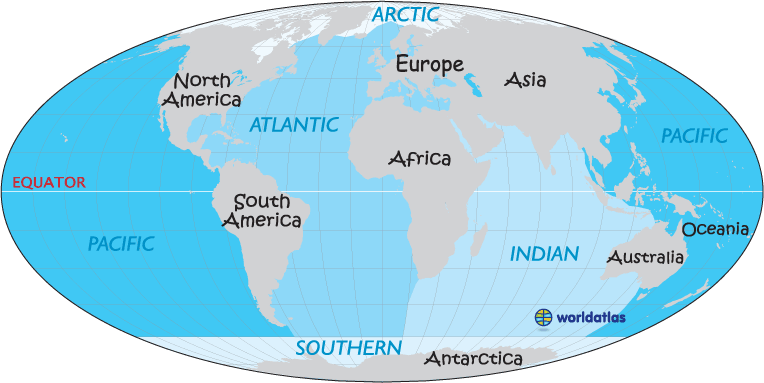Scroll down for printables.
The ocean is the lifeblood of Earth, covering more than 70 percent of the planet’s surface, driving weather, regulating temperature, and ultimately supporting all living organisms by producing 70 percent of our planet’s oxygen. Throughout history, the ocean has been a vital source of sustenance, transport, commerce, growth, and inspiration. Yet, we’ve barely scratched the surface of the sea, a place that an estimated one million species of animals call home. The ocean is a mystery that still has so much discovering waiting to happen.
Four or five basins
Earth has one global ocean that is divided into four named ocean basins: the Pacific, Indian, Atlantic and Arctic Oceans. Most countries now recognize the Southern (Antarctic) as the fifth ocean basin. The Pacific is the largest, covering 30 percent of Earth. At its widest point, from Indonesia all the way to Colombia, the Pacific Ocean is wider than the moon, by quite a lot. This expanse of ocean is 12,300 miles across, which is more than five times the diameter of the moon.

Cold, hot and deep
In the colder parts of the ocean, one finds massive icebergs. So big, in fact, that one iceberg can supply a million people with drinking water for five years. In the deepest parts of the ocean, the water temperature may be only 35–39 degrees Fahrenheit (2–4 degrees Celsius), with the exception of water coming out of hydrothermal vents in the seafloor. The water released from these vents can reach up to 750 degrees Fahrenheit (400 degrees Celsius). It’s the intense pressure at these depths — the same pressure that will crush you — that keeps the water from boiling.
Only 5 percent of the ocean has been explored, which leaves up to 95 percent of the ocean that is unknown. This includes volcanoes, canyons, life and an estimated three million shipwrecks spread across the ocean floor. We have a more detailed map of Mars than we do of our own waters.
Gold in each liter of seawater
Did you know that most of our gold is in our world’s oceans? According to the National Ocean Service, there is an estimated 20 million tons of gold suspended in the normal seawater. But this gold is spread throughout the normal mineral content of seawater to the tune of “parts per trillion.” Each liter of seawater contains, on average, about 13 billionths of a gram of gold. There are also gold deposits within the seafloor, but profitably mining them is far beyond our current abilities.
.
.
Questions:
- What percentage of Earth is covered by water?
- Name seven reasons why the ocean is so important.
- Find one word in the first paragraph that means “something (such as food) that keeps someone or something alive”.
- Find a synonym for hardly in the passage. (Par. 1)
- What are the four named ocean basins of the world.
- Which ocean basin is the largest?
- What percent of planet Earth does the Pacific Ocean cover?
- How many times is the Pacific wider than the moon?
- Find an antonym for narrowest in the passage. (Par. 2)
- How many people, and for how long, can be supplied with water from one massive iceberg?
- What is the temperature of water in the deepest parts of the ocean?
- How hot is the water that comes of out hydrothermal vents?
- What keeps the water from boiling?
- What percentage of the ocean has been explored?
- Name three things we can find in the ocean, that you will also find on the surface of planet Earth.
- Find one word in the passage that means “belonging to or existing in the present time.”
- Will Man set foot on Mars before being able to extract the gold in our oceans? What do you think?
.
.
Answers:
- More than 70%.
- The ocean drives weather, regulates temperature, produces oxygen, is a food source, is a mode of transport, creates trade, and is home to many animal species.
- Sustenance
- Barely
- Pacific, Atlantic, Indian and Arctic.
- Pacific
- 30%
- Five times wider.
- Widest
- One million people for five years.
- 35–39 degrees Fahrenheit (2–4 degrees Celsius).
- 750 degrees Fahrenheit (400 degrees Celsius).
- The intense pressure — the same pressure that would crush you.
- 5%
- Canyons, volcanoes, life.
- Current
- Open answer.
.
.
Printables:
Comprehension worksheet – passage only
Comprehension test – questions and answers only
Comprehension test with questions and answers per paragraph
.
Edublox offers cognitive training and live online tutoring to students with dyslexia, dysgraphia, dyscalculia, and other learning disabilities. Our students are in the United States, Canada, Australia, and elsewhere. Book a free consultation to discuss your child’s learning needs.

